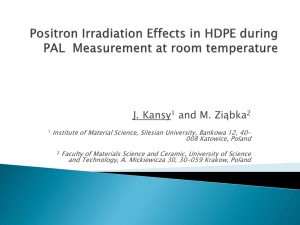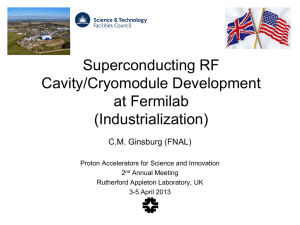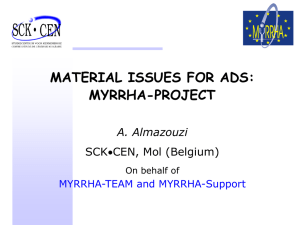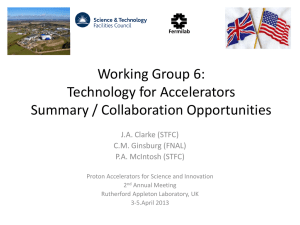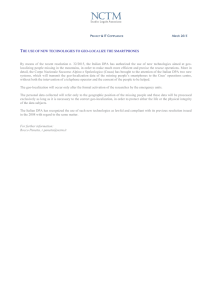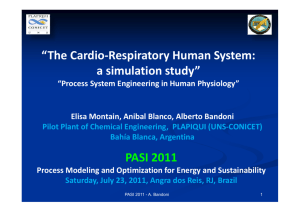Radiation Damage R&D Opportunities
advertisement
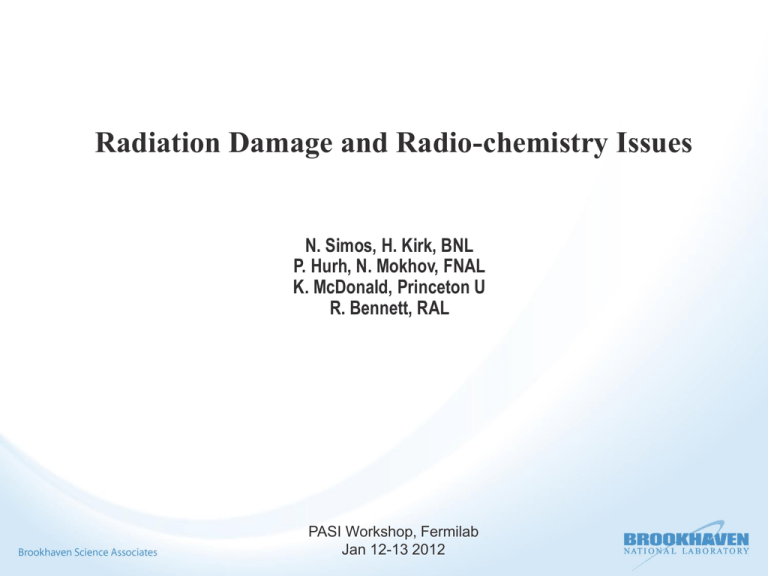
Radiation Damage and Radio-chemistry Issues N. Simos, H. Kirk, BNL P. Hurh, N. Mokhov, FNAL K. McDonald, Princeton U R. Bennett, RAL PASI Workshop, Fermilab Jan 12-13 2012 Parameter Space (damage is missing !!!) PASI Workshop, Fermilab, Jan 1213 2012 Motivation: Background – Irradiation Damage & Accelerators Need for multi-MW level operations and beams associated with proposed long baseline neutrino experiments (i.e. LBNE) Extrapolation of nuclear reactor experience data on radiation damage extremely risky Yield of useful pions/parents of the neutrinos of interest from low-Z materials is well matched to requirements of most neutrino experiments Peak energy deposition in low-Z targets is lowest; Graphite shown to exhibit superior thermomechanical performance confirmed by experience data from nuclear reactors Identification of limitations (if any) of lowZ materials under intense proton beams in support of MW-level experiments Elastic collisions (transferring of recoil energy to a lattice atom) leading to displaced atoms (dpa) Inelastic collisions transmutation products (H, He) Series of experiments at BNL using the 200 MeV Linac on materials, some with excellent performance in reactors (tens of dpa damage) showed presence of proton fluence threshold (~10^21 p/cm2) (LHC beam collimation studies at BNL first revealed shortcomings of carbon based materials) ...... realization For multi-MW level experiments, i.e. LBNE, apparent threshold COULD be a limiting factor Threshold is within year of operation at LBNE PASI Workshop, Fermilab, Jan 1213 2012 Radiation effects on materials Understand effects of irradiating species Energy Rate Operating Environment PASI Workshop, Fermilab, Jan 1213 2012 The Radiation Damage Problem Simplified Material properties change significantly as they are irradiated due to microstructural disorder Design limits vary with exposure In general: • • • Strength increases Ductility decreases Thermal/Electrical conductivity decreases Not only targets, but also windows, collimators, instrumentation, etc… Data for LE neutron irradiation is relatively plentiful, not so for HE proton irradiation PASI Workshop, Fermilab, Jan 1213 2012 The Radiation Damage Problem - Complicated Critical Mat’l properties sensitive to radiation damage include (note difference between LE neutron and HE proton): • Irradiation particle, e.g. • Irradiation temperature protons vs. neutrons • Transmutation (e.g. He, H) • Particle energy • Pulsed irradiation vs. • Flux or dose rate (dpa/s) continuous irradiation • Fluence or dose (dpa) • These constitute “damage correlation parameters” • Use these parameters to correlate damage from LE neutron to HE proton irradiation? – Could be powerful to harness the data from reactors for use in proton accelerator target facility designs PASI Workshop, Fermilab, Jan 1213 2012 The Radiation Damage Problem Complicated Material property changes are sensitive to many parameters (not captured by DPA): • • • • • • Tensile and yield strengths • Modulus of Elasticity • Coef. of Thermal Expansion • Heat Capacity • Electrical and Thermal Conductivity • Density/Dimensions (Swelling) • Fracture Toughness Fatigue Strength Irradiation creep Hydrogen/Helium Embrittlement Sonic velocity Corrosion resistance • “Threshold” of significant property change is material dependent – 0.02 DPA for graphite – 1-10 DPA for stainless steel PASI Workshop, Fermilab, Jan 1213 2012 Irradiation damage & Reversal how does it manifest its self both in micro- and macro-scales? irreversible ? Annealing or defect mobility at elevated temperature Observed Behavior: Increased defect density, damage acceleration upon re-exposure Why and what is the responsible mechanism? Does it apply with all alloys? PASI Workshop, Fermilab, Jan 1213 2012 Radiation Accelerated Corrosion Ionization of air surrounding a target by primary and secondary particles can create a very aggressive, corrosive environment High strength steel may suffer hydrogen embrittlement (MiniBooNE, NuMI) Coupled with radiation damage of material, not only accelerates corrosion, but changes the nature of the corrosion morphology (localized pitting versus uniform layer; NuMI decay pipe window) PASI Workshop, Fermilab, Jan 1213 2012 Radiation Accelerated Corrosion 10 Al 6061 samples displayed significant localized corrosion after 3,600 Mrad exposure NuMI target chase air handling condensate with pH of 2 NuMI decay pipe window concerns R.L. Sindelar, et al., Materials Characterization 43:147-157 (1999). PASI Workshop, Fermilab, Jan 12P. Hurh: High-Power Targets: Experience and R&D for 2 MW 3/30/11 13 2012 Radiation Accelerated Corrosion 11 Photograph of NuMI decay pipe US window showing corroded spot corresponding to beam spot PASI Workshop, Fermilab, Jan 12P. Hurh: High-Power Targets: Experience and R&D for 2 MW 3/30/11 13 2012 Any High Power Integrated Target System will be subjected to all that PASI Workshop, Fermilab, Jan 1213 2012 Use of BNL Accelerator Complex for Material Damage Direct protons (130-200 MeV) on materials Spallation neutrons, gammas, electrons and secondary protons (isotope targets serving as spallation targets – 2011 beam run) Why radiation damage at BLIP? Target Ep (GeV) Beam s (mm) Np (1/yr) DPA (1/yr) NuMI/LBNE 120 1.1 4.0e20 0.45 BLIP 0.165 4.23 PASI Workshop, Fermilab, Jan 121.124e22 1.5 13 2012 Graphite & Carbon Composites PASI Workshop, Fermilab, Jan 1213 2012 Graphite and C-C (Maruyama and Harayama 1992) PASI Workshop, Fermilab, Jan 1213 2012 (Snead 2009) Neutron irradiation of polygranular graphite (shrinkage at low doses and expansion at high doses.(Kasten et al 1969). PASI Workshop, Fermilab, Jan 1213 2012 Low-Z Targets and LBNE Graphite and Carbon-fiber composites Graphite widely studied and used in reactors Its behavior, however, remains elusive PASI Workshop, Fermilab, Jan 1213 2012 1021 p/cm2 fluence 0.2 dpa what happened to the 10s of dpa seen in thermal reactors? Observations were reproduced 3 times !! PASI Workshop, Fermilab, Jan 1213 2012 Graphite and carbon composites under high proton fluences (NuMI, J. Hylen) PASI Workshop, Fermilab, Jan 1213 2012 LBNE Target Experiment at BNL Linear Isotope Producer (BLIP) Experiment Objectives: • Establish relation between limiting fluence threshold and operating environment • Confirm damage & energy dependence (120 GeV vs. 180 MeV) • Identify the optimal low-Z microstructure when exposed to similar fluence/temp/environment conditions • Select the baseline target from material performance during LBNE test MARS Analysis Material damage dependency on proton energy and irradiation rate LBNE/NuMI & BNL BLIP Equivalence LBNE Target Array BNL BLIP Target Configuration NuMI “segmented” graphite target Target Ep (GeV) Beam s (mm) Np (1/yr) DPA (1/yr) NuMI/LBNE 120 1.1 4.0e20 0.45 BLIP 0.165 4.23 1.124e22 1.5 0.7-MW LBNE can be achieved at BNL BLIP over ~7 weeks PASI Workshop, Fermilab, Jan 1213 2012 What have LBNE Radiation Damage Experiments have shown: PASI Workshop, Fermilab, Jan 1213 2012 160 super INVAR (irrad) 140 irrad Graphite 120 Thermal Expansion (um) 100 80 60 40 20 0 0 50 100 150 200 250 300 350 400 450 500 -20 -40 350 Temp (C) 50 super INVAR (irrad) 40 300 30 250 irrad Graphite irrad Gum Thermal Expansion (um) Thermal Expansion (um) irradiated IG430 graphite 20 10 0 200 150 100 -10 50 -20 0 0 100 200 300 400 -30 0 100 200 300 400 500 600 700 800 900 1000 -50 Time (m) Temp (C) PASI Workshop, Fermilab, Jan 1213 2012 500 600 700 160 40 Annealing of Irradiated IG-430 (specimen T54) - Cycle 1 35 140 Note: During dweling there is no "annealing" due to the fact that the irradiation temperature is higher than the temperature of the two dwels 30 25 Temp (C) 100 20 80 15 60 10 40 5 Temp DL 20 0 0 0 20 40 60 80 100 120 time (min) PASI Workshop, Fermilab, Jan 1213 2012 140 160 -5 180 Linear Expansion (um) 120 200 40 Annealing of irradiated IG430 Graphite - Cycle 2 180 35 160 30 Temperature (C) 25 120 20 100 15 80 10 60 40 Temp 5 DL 0 20 0 0 50 100 150 200 250 time (min) PASI Workshop, Fermilab, Jan 1213 2012 300 350 -5 400 Thermal expansion (um) 140 Super Alloys PASI Workshop, Fermilab, Jan 1213 2012 super-Invar PASI Workshop, Fermilab, Jan 1213 2012 PASI Workshop, Fermilab, Jan 1213 2012 PASI Workshop, Fermilab, Jan 1213 2012 Ti-12Ta-9Nb-3V-6Zr-O [“gum” metal] T. Saito, et al., Multifunctional Alloys Obtained via a Dislocation-Free Plastic Deformation Mechanism, Science, 300 (2003) 464 PASI Workshop, Fermilab, Jan 1213 2012 Radiation effects on Mechanical Properties of Gum Metal From super-ductile to TOTALLY brittle ! WHY is it so susceptible? * bombardment of this “unstable” equilibrium * He formed & retained in grain boundaries PASI Workshop, Fermilab, Jan 1213 2012 Unique gum metal linear expansion behavior PASI Workshop, Fermilab, Jan 1213 2012 Irradiated Gum Metal PASI Workshop, Fermilab, Jan 1213 2012 Characterization using Photon Spectra PASI Workshop, Fermilab, Jan 1213 2012 Characterization using Photon Spectra PASI Workshop, Fermilab, Jan 1213 2012 PASI Workshop, Fermilab, Jan 1213 2012 Ti-6Al-4V PASI Workshop, Fermilab, Jan 1213 2012 High-Z Materials and Irradiation PASI Workshop, Fermilab, Jan 1213 2012 Experimental Set-Up addressing Oxidation/Volumetric Change (i.e. tantalum) 20 deg. C 625 deg. C Accelerated Ta Oxidation: Present of a third element Radiation-induced oxidation acceleration ? 1200 deg. C PASI Workshop, Fermilab, Jan 1213 2012 400 200 MeV Proton Irradiation of Tantalum T irrad ~ 400 C 350 Ta (0.2 dpa) Ta (0.2 dpa) Ta (0.4 dpa) 300 Ta (0.5 dpa) Ta (1.0 dpa) Stress (MPa) 250 Ta (2.0 dpa) Ta_unirrad 200 150 Work hardening dislocations in motion 100 50 0 0 5 10 15 20 25 Strain (%) PASI Workshop, Fermilab, Jan 1213 2012 160 80 20 0 CTE (1.0e-6/K) Tungsten -80 -160 -240 0 Irradiated W by 200 MeV protons (~1.5 dpa) Unirradiated W -320 -10 -400 400 W_unirradiate d W_irradiated -20 100 200 450 500 550 600 650 700 750 800 850 900 Temp (C) 300 400 500 600 40 Temp (C) 20 CTE (1.0e-6/K) CTE (x 10-6) 10 0 -20 Irradiated W by 200 MeV protons (~1.5 dpa) Unirradiated W -40 500 550 600 PASI Workshop, Fermilab, Jan 1213 2012 650 700 Temp (C) 750 800 850 900 100 0.28 Tantalum Oxidation/Thermal Expansion Correlation CTE (10-6/oK) 0.18 0.13 10 0.08 0.03 -0.02 CTE (unirradiated) CTE (proton irradiated, 1.5 dpa) -0.07 Weight Change (unirradiated) 1 100 200 300 400 500 Temp. (oC) PASI Workshop, Fermilab, Jan 1213 2012 600 700 800 -0.12 900 Weight Change (%) 0.23 1400 Proton Irradiated Tungsten 1200 T irrad ~ 400 C 1000 2 dpa (70% mass loss) Stress (MPa) W_irrad (1.0 dpa) 800 W_unirrad 600 400 200 Strain (%) 0 0 5 10 15 20 PASI Workshop, Fermilab, Jan 1213 2012 Irradiation, temperature and corrosive environment on Ni film with AL substrate Ni on aluminum: Magnetic Horn (NuMI Experiment) After irradiation Before irradiation PASI Workshop, Fermilab, Jan 1213 2012 Way Forward PASI Workshop, Fermilab, Jan 1213 2012 Radiation Damage R&D Opportunities Further irradiation and testing of promising target materials and "super" materials • Requires beam time, hot cell work & Material Science expertise Correlate LE neutron irradiation data to HE proton regime to take advantage of neutron irradiation data • Requires Material Science expertise & access to data Study effects of gas production in solid and liquid target materials • Requires Material Science, Radiochemistry, and Simulation expertise • May require testing PASI Workshop, Fermilab, Jan 1213 2012 Radiation Damage R&D Opportunities Irradiation tests to validate DPA and gas production simulation tools • Requires Material Science and Simulation expertise • Requires beam time & hot cell work Participate in activities to characterize irradiated materials from operating facilities (such as the SNS target vessel testing) • Requires Mechanical Engineering, Material Science expertise PASI Workshop, Fermilab, Jan 1213 2012 Radiation Damage R&D Opportunities Develop white paper outlining parameter space required for an irradiation test facility • Requires ME, Mat’l Science, Accelerator Physicist, and Simulation expertise Develop proposals for non-parasitic irradiation test sites at operating facilities (NuMI hadron absorber?) • Requires ME, Mat’l Science, Accelerator Physicist, and Simulation expertise PASI Workshop, Fermilab, Jan 1213 2012 BLAIRR The Brookhaven Linear Accelerator IRRadiation Test Facility To provide a test bed for: material irradiation under protons and neutrons (thermal and fast) Neutron scattering and damage assessment Unique Features Proton Energy Optimization and Selectivity for target material damage (FFAG and coupled cavities are explored) Selectivity of neutron spectra for material damage Neutron scattering for micro-scale damage evaluation PASI Workshop, Fermilab, Jan 1213 2012 Brookhaven Linear Accelerator IRRadiation Test Facility Present Future Parameter Space 92-200 MeV Proton Beam 105 μA Beam Sigma Spallation neutron spectrum from 112 MeV Protons Sharing Target Irradiation R Activities Material irradiation damage by proton irradiation Spallation neutron material irradiation Dedicated Target Space customized/optimized Synchronous proton and neutron irradiation damage Utilization of Spatial properties of spallation neutron spectrum Tunable proton energy to several hundred MeV (optimized according to the primary target and the neutron spectra desired) MOST importantly use spallation neutrons for neutron scattering studies of irradiation damage N. Mokhov PASI Workshop, Fermilab, Jan 1213 2012 BLAIRR – A Unique, ALL IN ONE OPERATION High Rate Irradiation Damage from Energetic Protons Fast Neutron Irradiation or Fast and Fusion Reactor Materials Crystal and Special Detector Performance Degradation Neutron Scattering based Damage Assessment Macroscopic Damage Assessment Computational Damage Model Verification PASI Workshop, Fermilab, Jan 1213 2012 Molecular Dynamics and Damage Evolution Fragment track and thermal spike on the surface of fused silica bombarded with energetic particles CZT crystal PASI Workshop, Fermilab, Jan 1213 2012 Irradiation & macroscopic assessment o Molecular Dynamics o Monte-Carlo analysis Visualization of damage (X-ray probing/strain mapping) Light Source Re-engineering of nano- /micro-structure at CFN PASI Workshop, Fermilab, Jan 1213 2012

